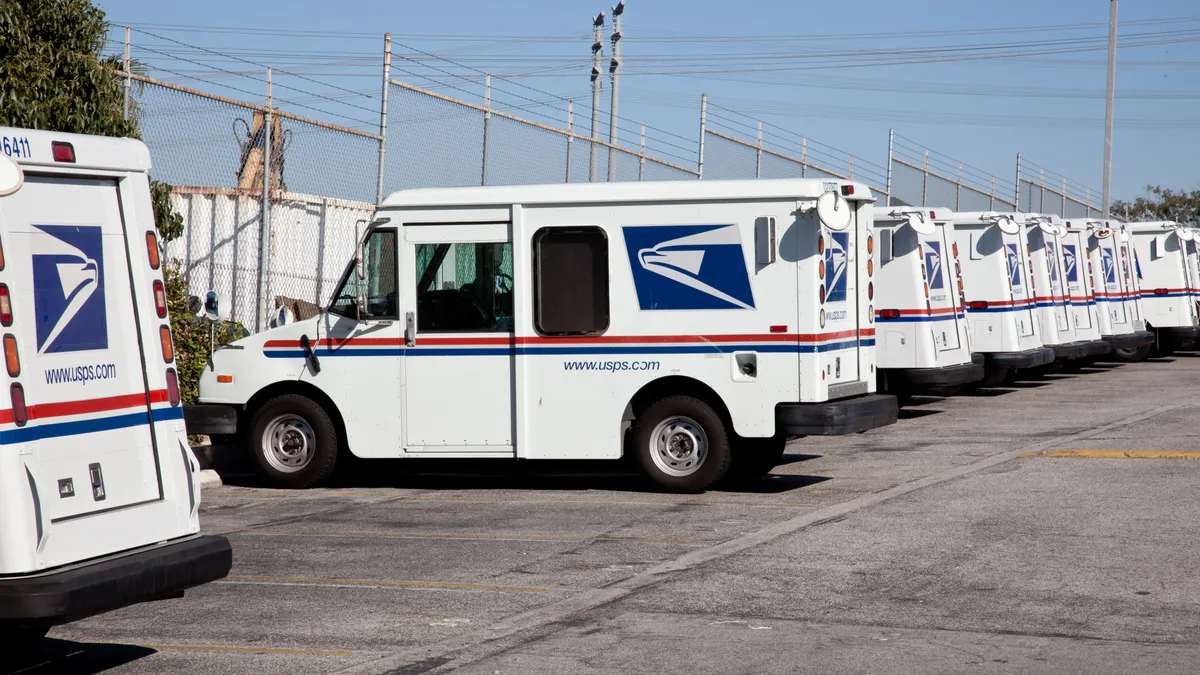Dive Brief:
- The U.S. Postal Service on Tuesday announced it has awarded Oshkosh Defense a 10-year contract to deliver up to 165,000 "next generation delivery vehicle" mail trucks that will "be equipped with either fuel-efficient internal combustion engines (ICE) or battery electric powertrains."
- The news disappointed some electric vehicle (EV) advocates, who said a decision by USPS to go all-electric would have sent important growth signals to the automotive market and supply chain. The postal service responded that the procurement allows for flexibility as vehicle technology advances.
- President Joe Biden in January called to transition the federal government's vehicle fleet to all-electric, generating optimism within the EV sector for increased adoption. The postal service's decision "was a missed opportunity to provide that signal," said Jimmy O'Dea, senior vehicles analyst at the Union of Concerned Scientists.
Dive Insight:
Experts say neither Biden's executive order on electrification, nor the postal service's procurement announcement, contain sufficient details to predict what will ultimately happen with the federal fleet. But for now, some see a lost chance.
"The lack of a clear commitment to electrification by the USPS is surprising," O'Dea said. "The announcement leaves the door open to electrification, but the question is how wide."
USPS said the initial $482 million modernization investment would reduce fleet costs and greenhouse gas emissions, and that the full modernization effort will run into the billions of dollars. Oshkosh has been selected to design and assemble 50,000 to 165,000 of the "purpose-built, right-hand-drive" vehicles for mail and package delivery.
A postal service representative said there is no information available on how many of those vehicles will be electric or gas-powered.
"The Postal Service recognizes that powertrain technology may change significantly over the available 20-year life of the [next generation delivery vehicle], and as such, the USPS selected a flexible design platform that can accommodate advancements in technology," spokesperson Kim Frum said in an email.
The flexible platform, Frum said, will allow the postal service to purchase delivery vehicles with powertrains "that maximize fuel efficiency, reduce operational costs and allow the incorporation of emerging technologies in the future (i.e., retrofit the drivetrains to other technologies) when they become mature and offer operational savings."
O'Dea lamented the lack of "clear signals" sent by the USPS, which is an independent agency of the federal government. Biden's executive order on fleet electrification was "pretty low on details," he said, essentially "just a sentence" directing agencies to come up with a plan on how to transition the federal fleet to zero emissions.
Joel Levin, executive director of Plug in America, said his group is also disappointed with the USPS decision.
"This will lock USPS into an outdated technology for many years, just at the moment when the world is shifting away from ICE engines," Levin said in an email. "This could have been such a great model for forward-looking procurement of fleet vehicles."
Levin also noted that the language of the USPS announcement "sounds like there is some wiggle room to shift to EVs for a portion of the contract," and that the contract decision may have been too far along for the Biden administration to alter.
"I would encourage [the Biden administration] to move as quickly as they can to see how much of this procurement can be salvaged," Levin said.
O'Dea agreed, saying the USPS contract decision "has been in the works for several years ... there were things in motion, irrespective of Biden's announcement."
EV advocates also say they are disappointed because mail trucks are prime candidates for electrification, as they operate on short, predictable routes and could return to a home depot for charging. "I can't think of a better use case," O'Dea said.
"Given the short distance that their vehicles typically travel, it would seem like a perfect use case for EVs," Levin added.
The Zero Emission Transportation Association, which advocates for policies supporting U.S. vehicle electrification by 2030, also opposes the USPS decision. In a statement, the group said continuing to utilize ICE vehicles would "lock our postal vehicle fleet into decades of carbon-intensive transportation," adding that the decision "directly conflicts" with the Biden administration's stated goals "and is certain to see swift pushback."
Securing America's Future Energy (SAFE), which advocates for "transformative transportation and mobility technologies," said it is disappointing USPS did not "immediately commit to electrifying one of our nation's largest vehicle fleets."
"This contract is a golden opportunity to stimulate the domestic EV market and supply chain," SAFE President and CEO Robbie Diamond said in a statement.
Not all EV advocates were disappointed, however.
Overall, "it's great to see that U.S. workers will be making much-needed updates to the postal fleet," Luke Tonachel, director for clean vehicles and fuels at Natural Resources Defense Council, said in an email.
Although "there might be some near-term constraints" to the USPS going all-electric now, the agency can still "ensure that the overwhelming share of these vehicles are electric," he added.















